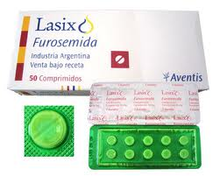Recently, the Kentucky Horse Racing Commission has backed a proposal to ban the use of furosemide, also marketed as Lasix and Salix, on race day. For years, use of furosemide has been the common choice of treatment to reduce exercise induced pulmonary hemorrhage (EIPH) in horses and it is currently the only legal medication that is allowed to be administered to a horse on the day of a race.

Furosemide marketed as Lasix and Salix
Furosemide is used to reduce or prevent the condition of EIPH, which is when a horse bleeds from its lungs during intense exercise.
Furosemide is a strong diuretic that causes the fluid in a horse’s body tissue to be released and then passed through the urine. The medication is used to reduce or prevent the condition of EIPH, which is when a horse bleeds from its lungs during intense exercise.
Horses with this condition are commonly called “bleeders,” and the condition often becomes a lifelong and chronic condition. So far, studies on the effects of furosemide have conflicting results on the medications ability to prevent bleeding in the horse's lungs. Although horses on the medication do appear to race more effectively, some researchers say that the better racing times are achieved by the weight loss that accompanies use of furosemide, since horses eliminate a quantity of liquid from their systems as urine when on the medication.
With the lengthy legislative process, the proposed plan for gradually eliminating the use of Lasix/furosemide in Kentucky will not begin until January 1, 2014. The regulation would apply only to racing Quarter Horses and Thoroughbreds, starting with the two-year-old graded and listed stakes. According to the proposed timeline, in 2015 it would apply to both two- and three-year-olds, then by 2016 the use of Lasix on race day would be banned for all horses racing in Kentucky.
About Microcurrent Therapy:
According to Deborah Powell, microcurrent therapy which is a treatment method originated by Matrix Therapy Products is an alternative method that has been used for years to avoid using furosemide and to successfully treat EIPH in race horses. Microcurrent therapy is a non-invasive treatment that provides healing elements, making it a safer and healthier option for the horse. Unlike Lasix, the microcurrent Lung Treatment has been reported to actually help heal the horse’s lungs, which can provide longer-lasting results. Additionally, there are no bans on the use of microcurrent therapy.
According to information from Matrix, the Lung Treatment method has been reported to be consistently reliable, whereas studies on the effects of Lasix have provided varying results. The microcurrent treatment greatly improves the horse’s comfort levels, and pre-race checks with an endoscope have showed previous bleeders to have clear lungs.
Ideally, once a horse is diagnosed with EIPH or suspected to have it, the horse would be treated three days in a row with the microcurrent Lung Treatment prior to a race.
